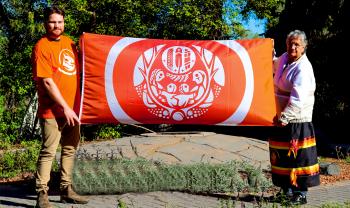Image Caption
The National Centre for Truth and Reconciliation (NCTR) has unveiled a new Survivors’ Flag to mark the first official National Day of Truth and Reconciliation.
This commemorative flag was created by survivors to share their expression of remembrance with the broader public, and to honour all residential school survivors, families, and communities impacted by the residential school system in Canada.
The flag, unveiled Sept. 23, was developed through six weeks of consultation, discussion and collaboration with Inuit, Mi’kmaq, Atikamekw, Cree, Ojibway, Dakota, Mohawk, Dene, Nuu-chah-nulth, Secwepemc, and Métis survivors, reads a press statement.
“Earlier this year, the discoveries of unmarked burials at former residential schools compelled many survivors to reflect on remembrance of the experiences they survived and of their fellow students who did not return home,” said Stephanie Scott, executive director of the NCTR.
“The Survivor’s Flag represents the thoughts, emotions, experiences and hopes expressed by Survivors who have shared their truths about residential schools. The flag affirms commitment to the remembrance of the lives lost through, and the lives impacted by the residential school system.”
The centre will distribute official flags to the survivors who contributed to its design and to a number of Indigenous organizations to incorporate into the National Day for Truth and Reconciliation events.
The Survivors flag will also soon be available for purchase to the general public, including in additional formats, such as car flags, window decals, and lawn signs online at nctr.ca/exhibits/survivors-flag

